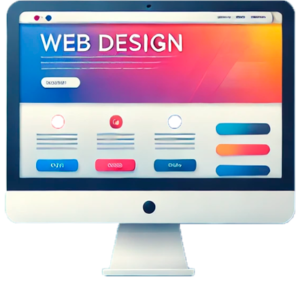Top Web Design Trends for 2025: What’s Next for User Experience?

The world of web design is ever-evolving, driven by advancements in technology and shifting user expectations. As we move into 2025, it’s clear that innovation will continue to shape how websites are built and experienced. This guide explores the top web design trends for 2025, offering insights into what’s next for user experience (UX).
Table of Contents
Why Keeping Up with Web Design Trends Matters
Staying ahead of web design trends isn’t just about aesthetics; it’s about functionality, user engagement, and SEO performance. Websites that align with modern expectations tend to perform better in search rankings, retain users longer, and convert visitors into customers more effectively. Understanding upcoming trends ensures your website remains competitive in an increasingly digital world.
1. AI-Driven Personalization
Artificial intelligence (AI) continues to revolutionize web design by enabling personalized user experiences. In 2025, expect websites to leverage AI to deliver:
Dynamic Content: Websites will adapt content based on user behavior, preferences, and browsing history.
Chatbots: AI-powered chatbots will become more conversational and intuitive, offering real-time assistance tailored to individual needs.
Predictive Analysis: AI tools will anticipate user actions and suggest relevant products, services, or content.
How to Implement AI-Driven Personalization
Use platforms like Adobe Sensei or IBM Watson to integrate AI capabilities.
Collect and analyze user data ethically and transparently.
Test personalization strategies to ensure they enhance user satisfaction.
2. Immersive 3D Elements
The use of 3D visuals will become more prevalent as web browsers and devices improve their rendering capabilities. These elements create depth, interactivity, and a memorable user experience.
Applications of 3D in Web Design
Product Showcases: Interactive 3D models allow users to examine products in detail.
Virtual Tours: Industries like real estate and hospitality can offer immersive experiences directly on their websites.
Animated Backgrounds: Subtle 3D animations add visual appeal without overwhelming users.
Best Practices for Using 3D
Optimize 3D elements to avoid slow loading times.
Ensure compatibility across devices and browsers.
Use 3D sparingly to maintain a clean design.
3. Dark Mode 2.0
Dark mode isn’t new, but in 2025, it’s evolving into a more sophisticated feature. Designers will focus on creating dynamic dark mode experiences that adapt to:
Ambient Lighting: Websites will automatically adjust based on the user’s environment.
Customizable Themes: Users can choose their preferred color schemes, enhancing accessibility.
Why Dark Mode Matters
Reduces eye strain, especially in low-light conditions.
Saves battery life on OLED and AMOLED screens.
Offers a sleek and modern aesthetic.
4. Voice User Interfaces (VUIs)
With the rise of voice search, integrating voice user interfaces into web design is becoming crucial. VUIs allow users to navigate websites and access content through voice commands, improving accessibility and convenience.
Benefits of VUIs
Accessibility: Makes websites usable for people with disabilities.
Speed: Users can find information faster without typing.
Hands-Free Navigation: Ideal for on-the-go browsing.
Tips for Implementing VUIs
Use tools like Google’s Speech-to-Text API.
Ensure voice commands are simple and intuitive.
Optimize your website’s content for voice search queries.
5. Sustainability-Focused Design
As environmental awareness grows, sustainable web design is gaining traction. This trend emphasizes creating websites that are both energy-efficient and eco-friendly.
Key Features of Sustainable Design
Lightweight Code: Minimizes server load and reduces energy consumption.
Green Hosting: Partners with hosting providers that use renewable energy.
Minimalist Design: Focuses on essential elements to improve performance and user experience.
6. Micro-Interactions for Enhanced Engagement
Micro-interactions are subtle animations or effects triggered by user actions. These elements create a more engaging and interactive experience without overwhelming users.
Examples of Micro-Interactions
Hover Effects: Highlight buttons or links when hovered over.
Loading Animations: Entertain users during loading times.
Form Feedback: Show real-time validation for form inputs.
Implementing Micro-Interactions
Use CSS animations or JavaScript libraries like Framer Motion.
Keep animations fast and fluid to avoid distracting users.
Test interactions to ensure they align with your website’s purpose.
7. Augmented Reality (AR) Integration
Augmented reality is becoming more accessible, offering unique ways to engage users. By integrating AR, websites can provide:
Virtual Try-Ons: Let users see how products like clothing or furniture fit into their lives.
Interactive Learning: Enhance educational content with AR simulations.
Enhanced Storytelling: Create immersive narratives that captivate users.
AR Tools for Web Design
Use WebAR platforms like 8thWall or ZapWorks.
Ensure AR experiences work seamlessly on both desktop and mobile devices.
8. No-Code and Low-Code Development
No-code and low-code tools are empowering designers to build complex websites without extensive programming knowledge. These platforms accelerate development while maintaining high-quality results.
Popular No-Code Tools
Webflow
Wix
Bubble
Benefits of No-Code Development
Reduces development time.
Makes web design accessible to non-developers.
Allows for rapid prototyping and iteration.
9. Focus on Accessibility
Accessibility is no longer optional. Websites in 2025 will prioritize inclusivity to ensure all users can access content, regardless of abilities.
Accessibility Best Practices
Use descriptive alt text for images.
Ensure color contrasts meet WCAG standards.
Implement keyboard navigation and screen reader compatibility.
10. Enhanced Mobile-First Design
Mobile-first design isn’t just a trend; it’s a necessity. With the majority of web traffic coming from mobile devices, websites must prioritize mobile experiences.
Key Elements of Mobile-First Design
Responsive Layouts: Ensure content adapts seamlessly to different screen sizes.
Fast Load Times: Optimize images and code for quick loading.
Touch-Friendly Interfaces: Design buttons and menus for easy navigation on touchscreens.
Conclusion
The top web design trends for 2025 reflect a shift toward personalization, interactivity, and sustainability. By embracing these trends, designers can create websites that not only look stunning but also deliver exceptional user experiences. Staying ahead of these trends will ensure your website remains relevant, competitive, and capable of meeting the ever-changing expectations of users.
